A Design Method of Styreneic Methyl Copolymers Normal Temperature Modified Asphalt Mixture Based on Performance Balance
Abstract
1. Introduction
2. Materials
3. Design of the Aggregate Gradation
4. Determination of Optimum Asphalt Aggregate Ratio
5. Performance Verification
5.1. Anti-Rutting Performance
5.2. Water Stability
5.3. Low Temperature Anti-Cracking Performance
5.4. Engineering Application
6. Conclusions
- (1)
- Considering that the skeleton structure could enhance the high temperature of SMC normal temperature modified asphalt mixture, a recommended method for designing the gradation of SMC normal temperature modified asphalt was the power function curve model of the aggregate gradation. The key points of the aggregate gradation of 0.075 mm, 4.75 mm and the nominal maximum particle size were adopted in the method. The passing rate of 0.075 mm and 4.75 mm should be restricted at 6% and 30%, respectively, and the passing rate of the nominal maximum particle size should be kept at about 95%.
- (2)
- Considering the skeleton-density structure could solve the performance balance of SMC normal temperature modified asphalt mixture especially in terms of enhancing its high-temperature and water stability properties, on the basis of the quadratic curve model, a method for the determination of optimum asphalt aggregate ratio of SMC normal temperature modified asphalt mixture was put forward according to the relationship between asphalt aggregate ratio and , VMA and VCAmix.
- (3)
- The performance of SMC normal temperature modified asphalt mixture designed by using the design method based on performance balance could meet the requirements of the technical specifications perfectly. The method was effective in improving the overall performance of SMC normal temperature modified asphalt mixture. It is expected that more engineering project verifications will be conducted in future studies.
Author Contributions
Funding
Conflicts of Interest
References
- Cadorin, N.D.; Melo, J.; BroeringW, B.; Manfro, A.L.; Barra, B.S. Asphalt nanocomposite with titanium dioxide: Mechanical, rheological and photoactivity performance. Constr. Build. Mater. 2021, 289, 123178. [Google Scholar] [CrossRef]
- Sun, Y.; He, D. High and Low-Temperature Performance Evaluation and Microanalysis of SMCSBS Compound-Modified Asphalt. Materials 2021, 14, 771. [Google Scholar] [CrossRef]
- Tan, Y.; Zhang, H.; Cao, D.; Xia, L.; Du, R.; Shi, Z.; Dong, R.; Wang, X. Study on cohesion and adhesion of high-viscosity modified asphalt. Int. J. Tran. Sci. Tech. 2019, 8, 394–402. [Google Scholar]
- Tan, Y.; Zhang, L.; Xu, H. Evaluation of low-temperature performance of asphalt paving mixtures. Cold. Reg. Sci. Technol. 2012, 70, 107–112. [Google Scholar] [CrossRef]
- Zhao, L. Application of SMC modified asphalt at room temperature on G312 Line Manag. Tech. SME 2017, 8, 184–185. [Google Scholar]
- Qu, H. Application of SMC modified asphalt at room temperature in highway overlay engineering. Shanxi Constr. 2016, 42, 166–167. [Google Scholar]
- Luo, H.; Li, Z.; Zheng, P.; Ouyang, C.; Qiu, Y. Analysis of road performance, mechanism and environmental protection benefit of SMC room temperature modifier. J. Build. Mater. 2020, 23, 1144–1152. [Google Scholar]
- Liang, Q. Research on the performance of high RAP content SMC room temperature recycled asphalt mixture. West. Commun. Tech. 2020, 5, 10–13. [Google Scholar]
- Shu, P.; Wang, B.; Zhang, Y.; Wang, S. Research on performance of high RAP content SMC normal temperature recycled asphalt mixture in Panzhihua area. Transp. Energy Conserv. Environ. Prot. 2020, 16, 79–83. [Google Scholar]
- Tian, M.; Li, Y.; Luo, D.; Wang, Z. Study on fatigue performance of SMC recycled modified asphalt mixture with 50% RAP. J. Highw. Transp. Res. Dev. (Appl. Technol. Ed.) 2020, 16, 59–61. [Google Scholar]
- Tian, M.; Feng, Z.; Ya, F.; Yan, J. The SMC normal temperature reclaimed asphalt mixture mix design and performance evaluation research. DEStech Trans. Eng. Technol. Res. 2018, 225–229. [Google Scholar] [CrossRef]
- Liu, X.; Xu, G.; Liu, J.; Wang, S. Study on the optimum content of recycling agent for SMC normal temperature recycled asphalt mixture on S214 line of Panzhihua. Transp. Energy Conserv. Environ. Prot. 2020, 16, 98–102. [Google Scholar]
- OuYang, Y. The Evaluation of Comprehensive Performance of SMC Normal Temperature Modified Asphalt and the Asphalt Mixture. Master’s Thesis, Southwest Jiaotong University, Chengdu, China, 2017. [Google Scholar]
- Zhu, F.; Ma, Q.; Li, Y.; Hui, J.; Xiao, Y.; Chen, Y. Construction of SMC normal temperature asphalt mixture in Dongning area technical study. TranspoWorld 2021, 22, 130–132. [Google Scholar]
- Wang, H.; Rath, P.; Buttlar, W.G. Recycled asphalt shingle modified asphalt mixture design and performance evaluation. J. Traffic Trans. Eng. (Engl. Ed.) 2020, 7, 205–214. [Google Scholar] [CrossRef]
- Lv, S.; Wang, S.; Xia, C.; Liu, C. A new method of mix design for cold patching asphalt mixture. Front. Mater. 2020, 7, 182. [Google Scholar] [CrossRef]
- Xin, J.; Pei, J.; Akiyama, M.; Li, R.; Zhang, J.; Shao, L. A study on the design method for the material composition of small particle-size asphalt mixture for controlling cracks in asphalt pavement. Appl. Sci. 2019, 9, 1988. [Google Scholar] [CrossRef]
- Xiao, X.; Zhang, X.; Xiao, X. Design of porous asphalt mixture based on CAVF method. J. Highw. Transp. Res. Dev. 2016, 33, 7–12. [Google Scholar]
- Fu, Z.; Wang, B.; Li, J.; Sun, Q.; Zhang, P. Design method for fiber asphalt mixture based on fiber reinforcement performance. Road Mach. Constr. Mech. 2018, 35, 122–126. [Google Scholar]
- Shi, F.; He, Z.; LV, W.; Xu, B.; Zhu, L. Design method and laboratory research of foamed bitumen mixture. J. Highw. Transp. Res. Dev. 2004, 21, 1–4. [Google Scholar]
- Zhang, Y.; Liu, Z. Study on the design method of emulsified asphalt mixture. Highw. Eng. 2016, 41, 263–267. [Google Scholar]
- Liu, J. Design of mix proportion and performance validation of SMC ultrathin overlays under normal temperature. Railw. Conctruction Technol. 2018, 292, 36–39. [Google Scholar]
- Feng, Z.; Li, Y.; Wang, S. Mix proportion design method and performance verification of SMC normal temperature recycled asphalt mixture. J. Highw. Transp. Res. Dev. (Appl. Technol. Ed.) 2018, 14, 44–45. [Google Scholar]
- Xie, Z. Research on Properties of Recycled Asphalt Mixture with High RAP Content and SMC at Room Temperature. Master’s Thesis, Southwest Jiaotong University, Chengdu, China, 2017. [Google Scholar]
- Ozawa, K. Design Method for mixing formulas of asphalt mixtures considering aggregate voids. J. Jpn. Pet. Inst. 2002, 45, 70–76. [Google Scholar] [CrossRef][Green Version]
- China Ministry of Transport. JTG E20-2011 Specifications and Test Methods of Bitumen and Bituminous Mixtures. For Highway Engineering; China Communications Press: Beijing, China, 2011. [Google Scholar]
- Ministry of Communications of the PRC. JTGE42-2005Test Methods of Aggregate for Highway Engineering; China Communications Press: Beijing, China, 2005. [Google Scholar]
- Zhao, Y.; Xu, T.; Huang, X.; Li, Z. Gradation design of the aggregate skeleton in asphalt mixture. J. Test. Eval. 2012, 40, 1071–1076. [Google Scholar] [CrossRef]
- Zhang, X.; Guo, Z.; Wu, K. Volume method of bituminous mixture design. J. Harbin Univ. Archit.Eng. 1995, 28, 28–36. [Google Scholar]
- Vavrik, W.; Pine, W.; Carpenter, S. Aggregate blending for asphalt mix design bailey method. Transp. Res. Rec. J. Transp. Res. Board 2002, 1789, 146–153. [Google Scholar] [CrossRef]
- Zhang, Y.; Zheng, M.; Hu, G.; Zhu, Q. Coarse aggregate gradation design index and method of asphalt mixture. Adv. Mater. Res. 2013, 724–725, 1489–1494. [Google Scholar] [CrossRef]
- Xu, S.; Peng, G.; Zhang, Y.; Guo, Y. Design Method of asphalt pavement mixture based on performance balance approach. J. Transp. Eng. Part B Pavements 2021, 147, 04021009. [Google Scholar] [CrossRef]
- Li, L. Design method study on the large-stone flexible base durable asphalt pavement of resisting rutting. Ph.D. Thesis, Central South University, Changsha, China, 2011. [Google Scholar]
- Miao, C.; You, H.; Lu, Y.; Zuo, G. Analysis and discuss on the inspection method of skeleton framework formation of bituminous mixture. J. Transp. Eng. Inf. 2009, 7, 72–80. [Google Scholar]
- Huang, Y.; Liu, C.; Wang, X.; Yang, G. Proportion design method of asphalt mixture based on the most compact state of skeleton. J. China Foreign Highw. 2016, 36, 216–221. [Google Scholar]
- Liu, S.; Luan, J.; Xue, Z.; Chen, L.; Cao, W. Model and analysis of voids in the mineral aggregate for the same type of hot mix asphalt at different gradations. J. Build. Mater. 2022, 25, 158–163. [Google Scholar]
- Li, L.; Guo, Z.; Ran, L.; Zhang, J. Study on low-temperature cracking performance of asphalt under heat and light together conditions. Materials 2020, 13, 1541. [Google Scholar] [CrossRef] [PubMed]
- Ministry of Communications of the PRC. JTGF80/1-2004 Quality Inspection and Evaluation Standards for Highway Engineering; China Communications Press: Beijing, China, 2004. [Google Scholar]

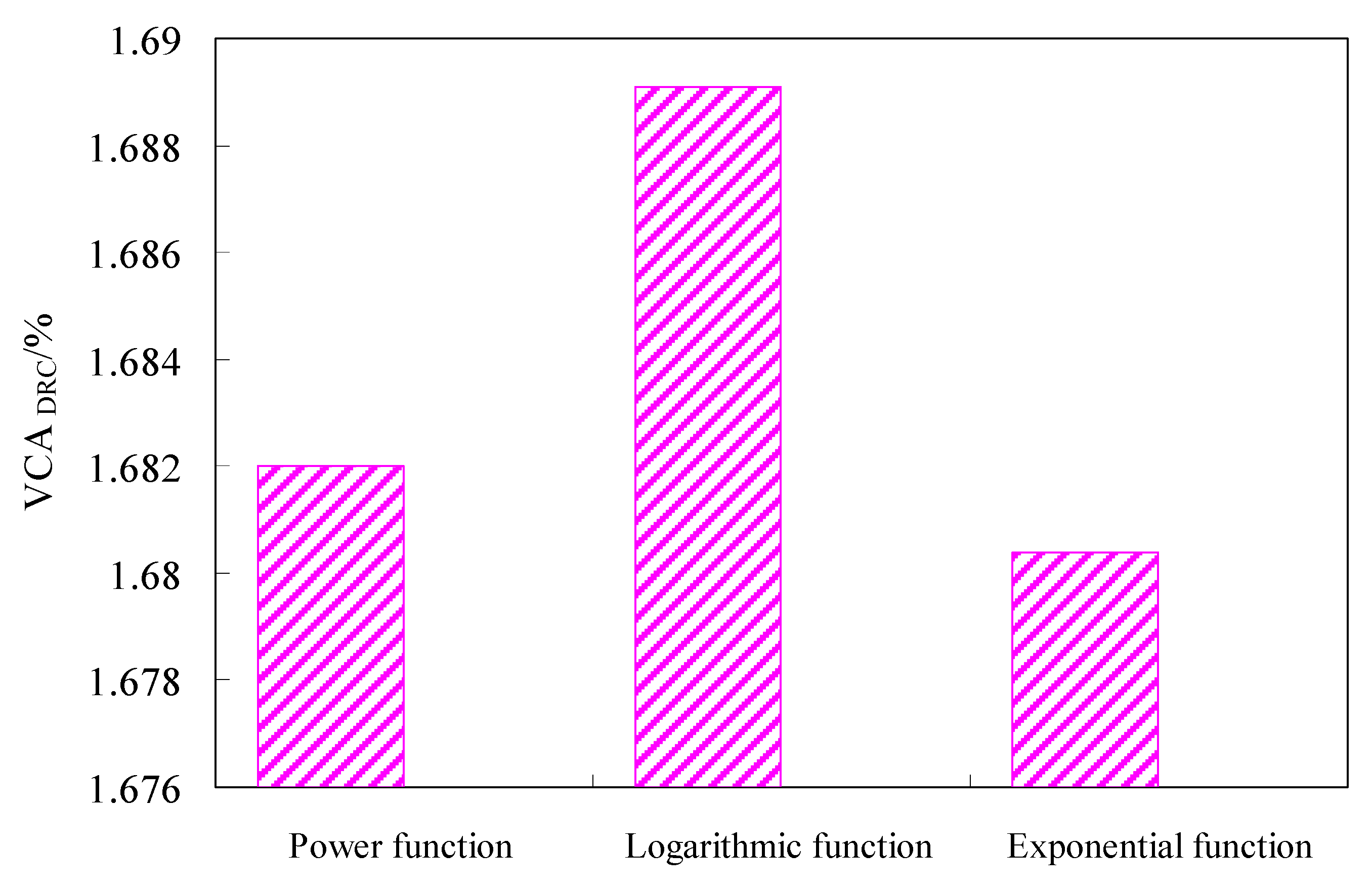
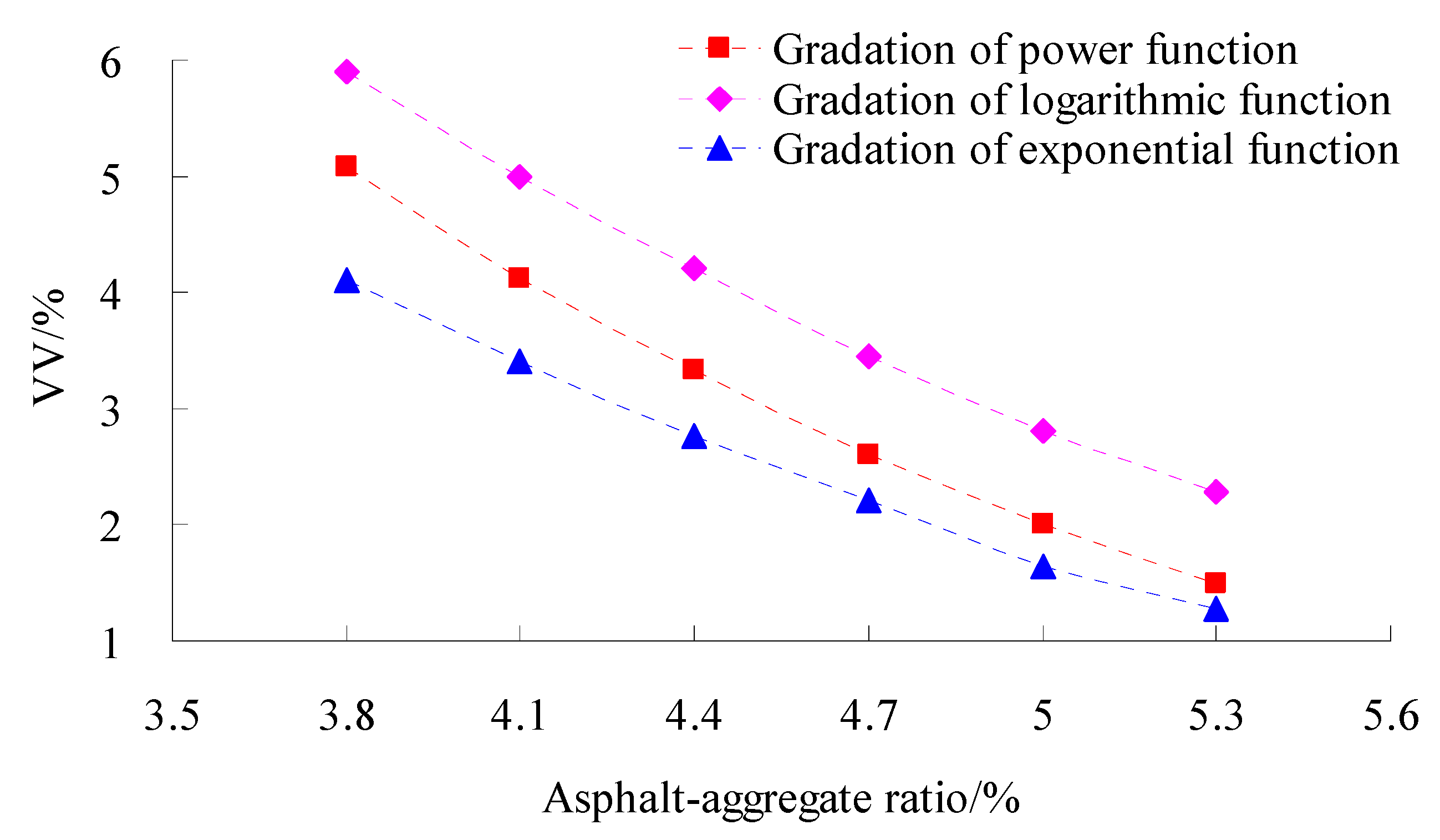
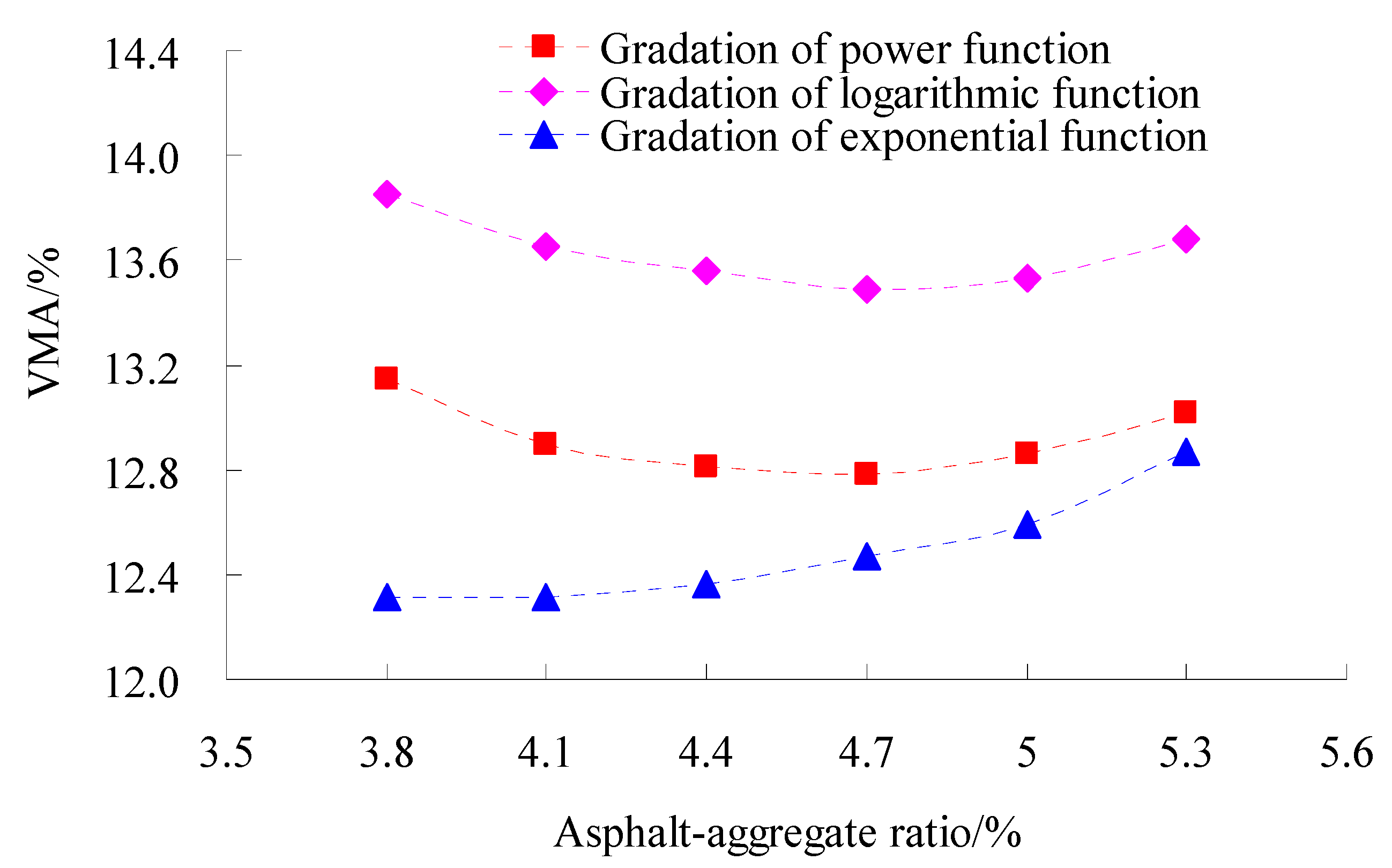
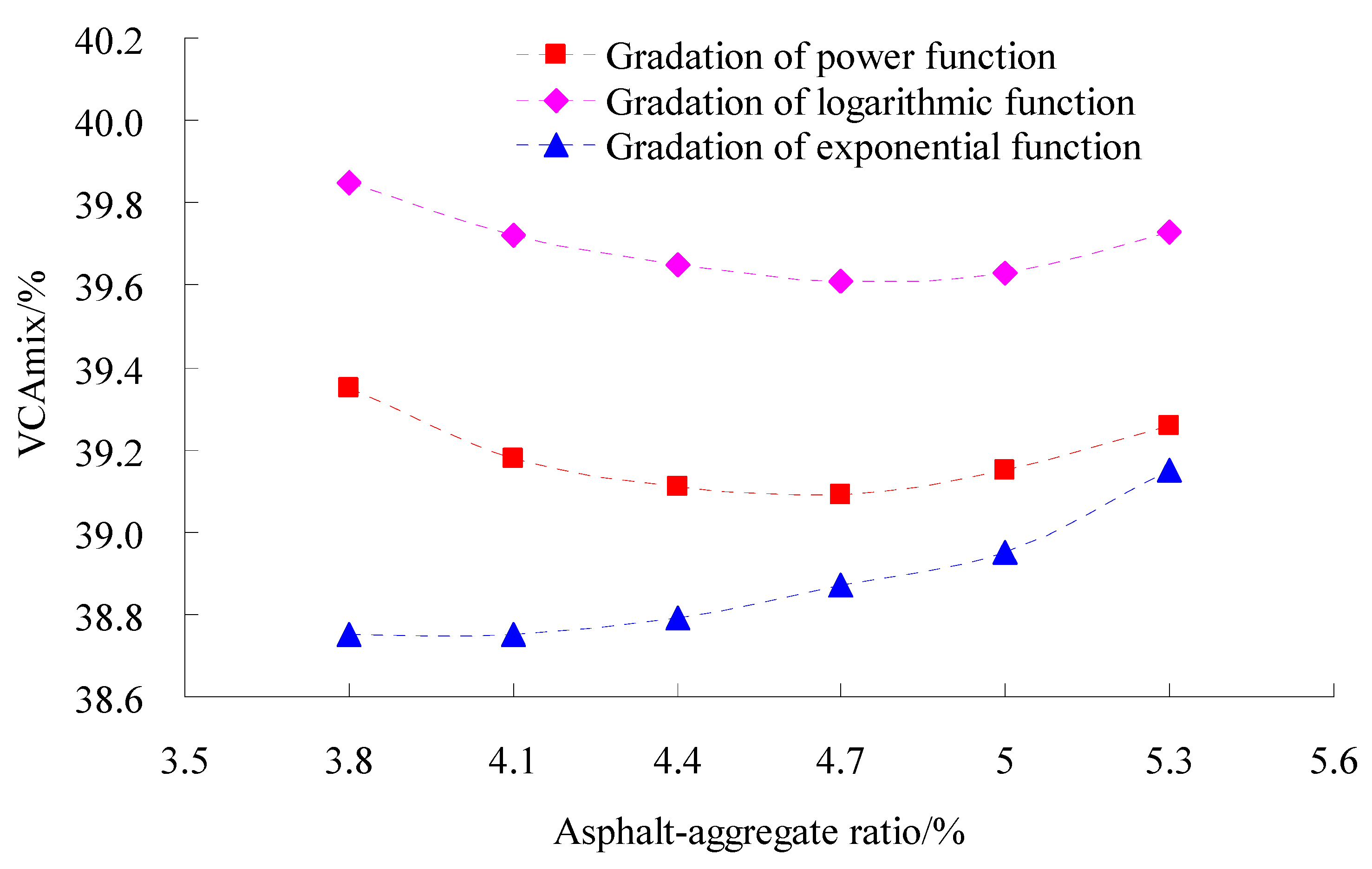
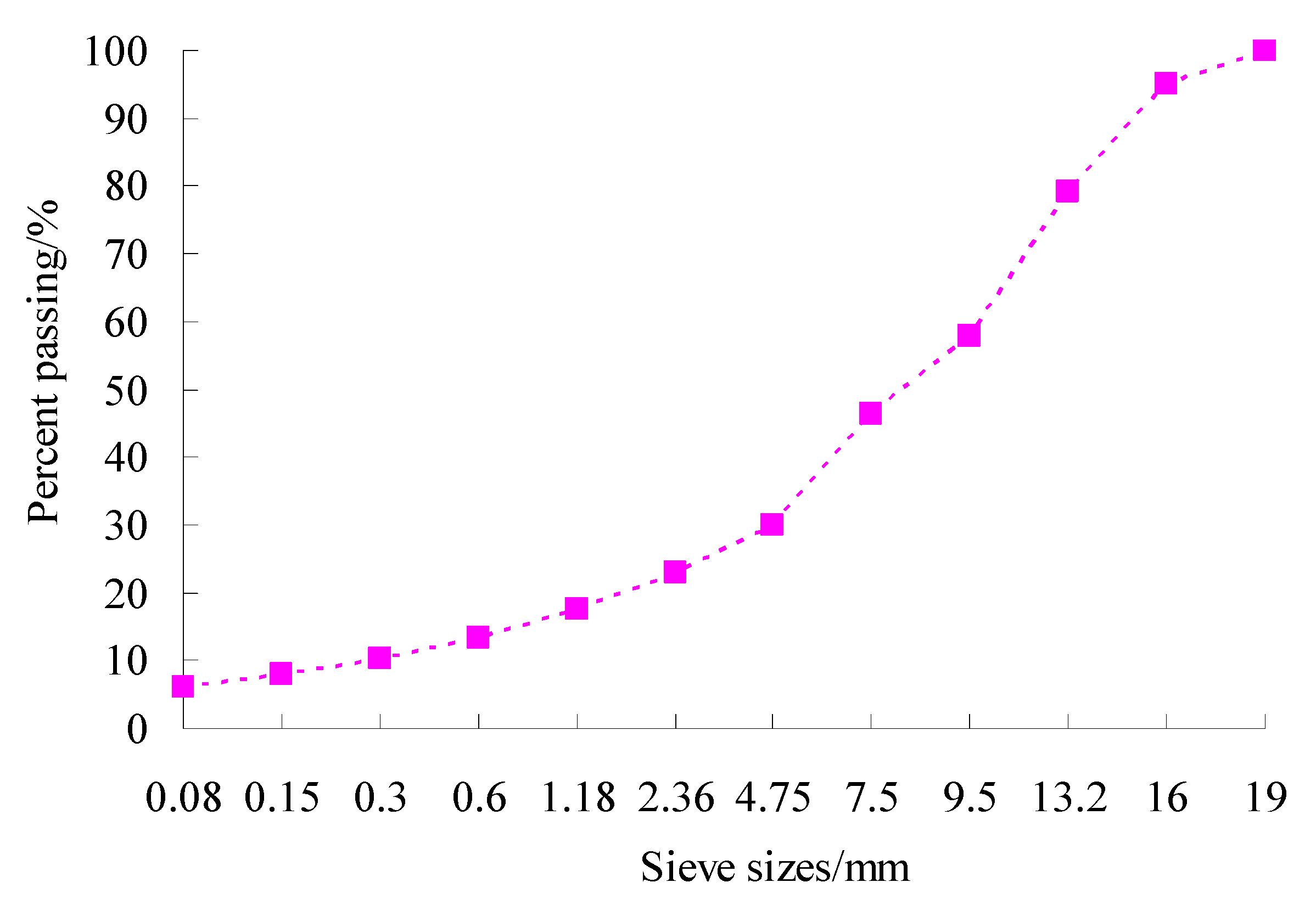

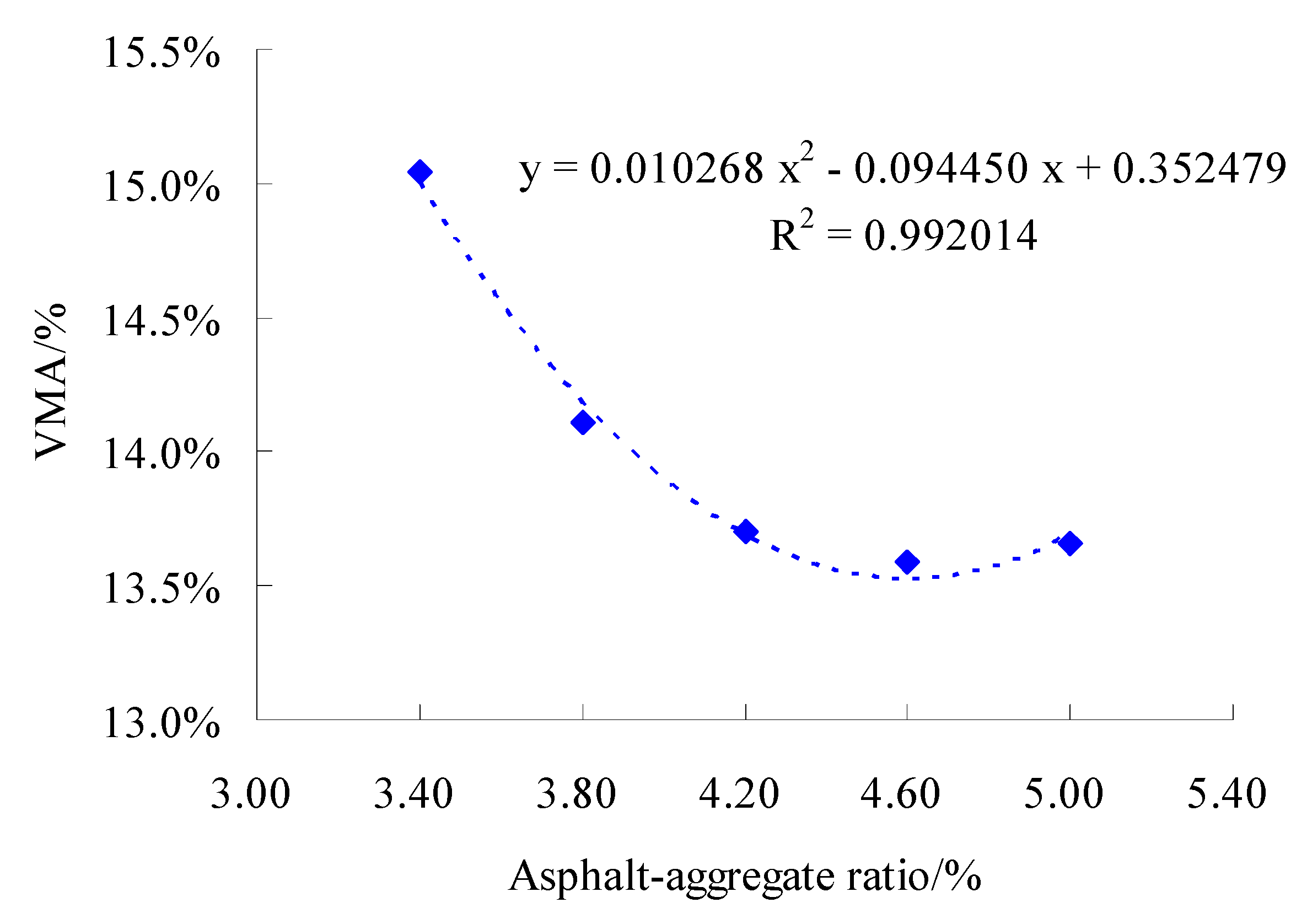
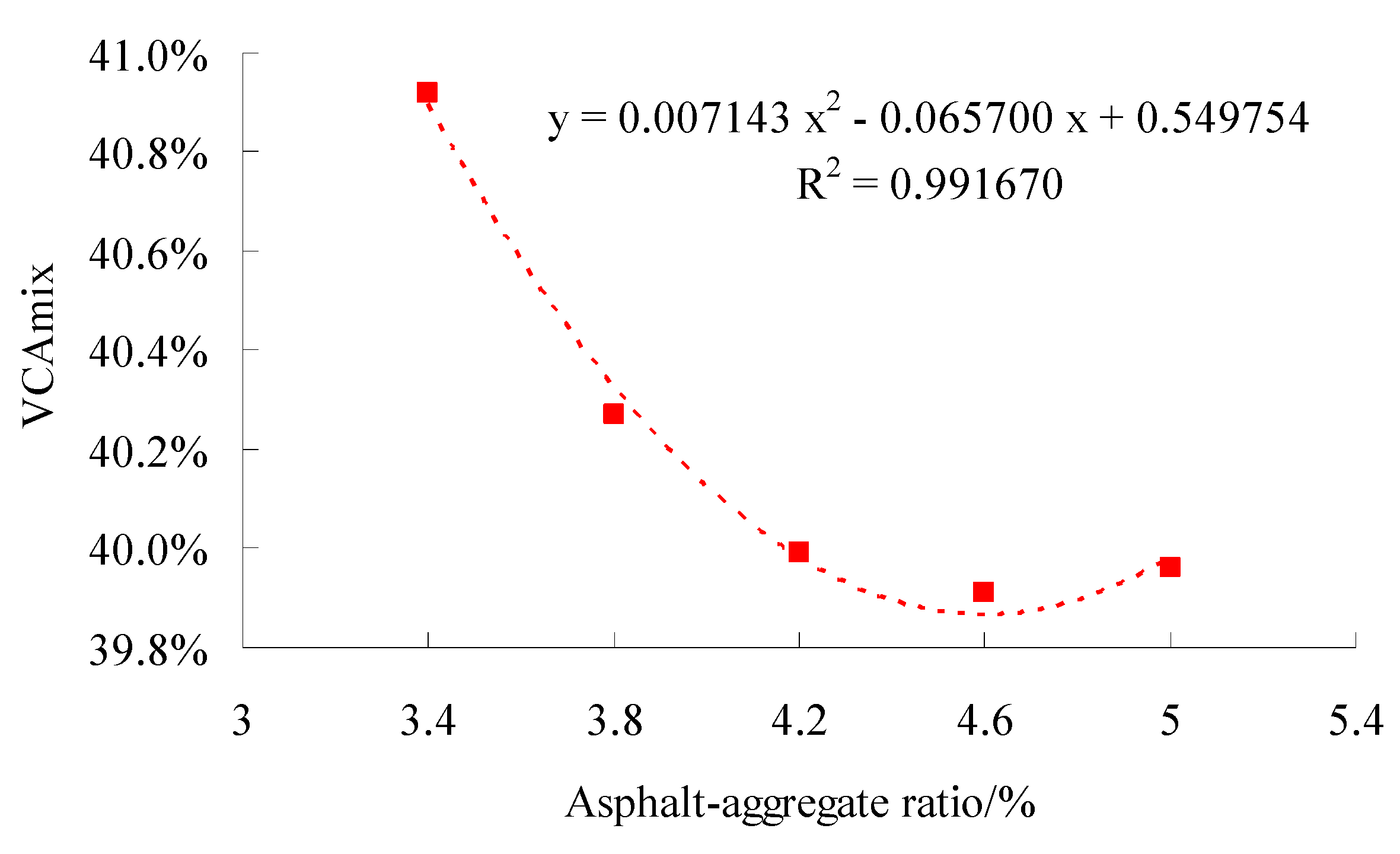
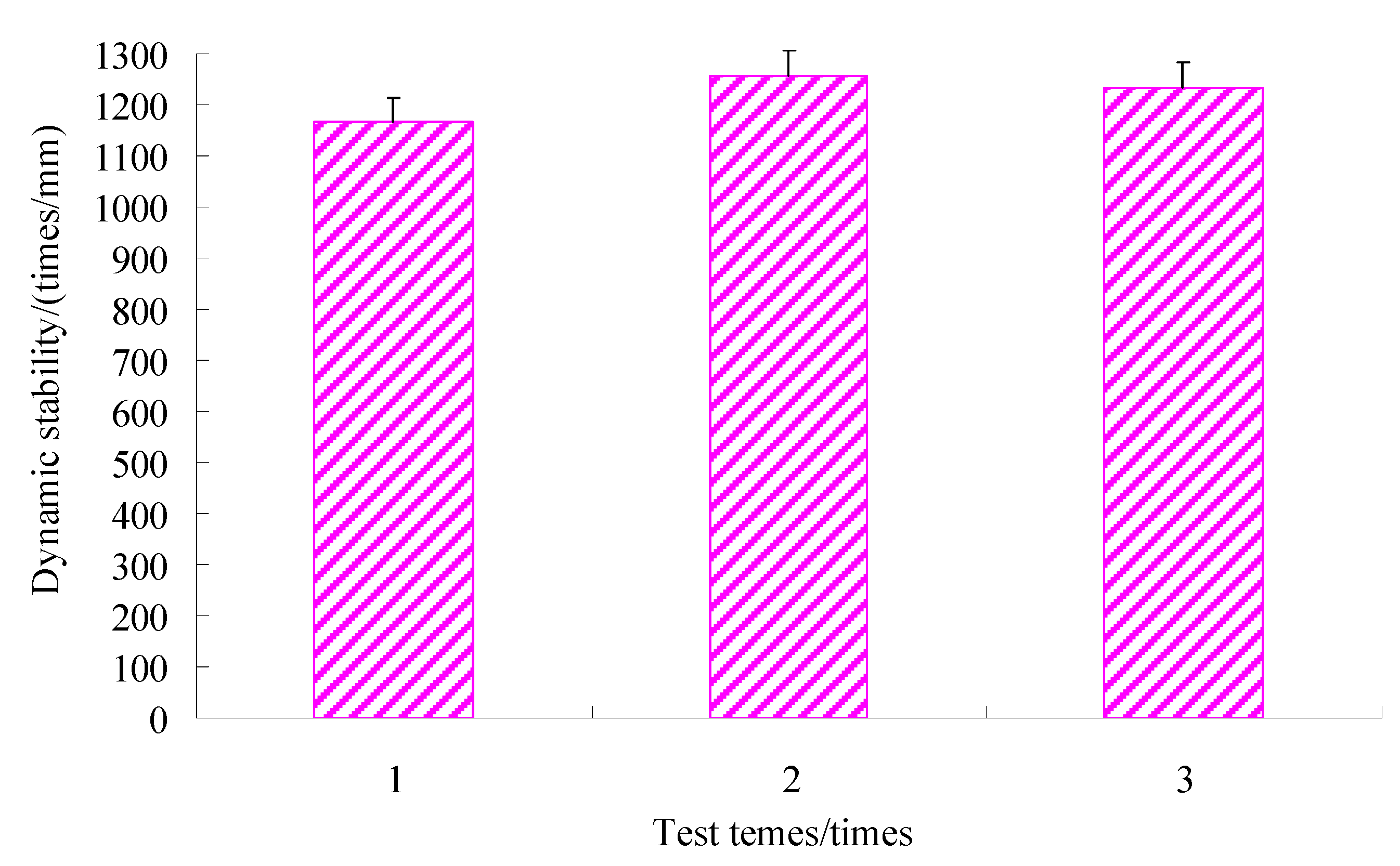

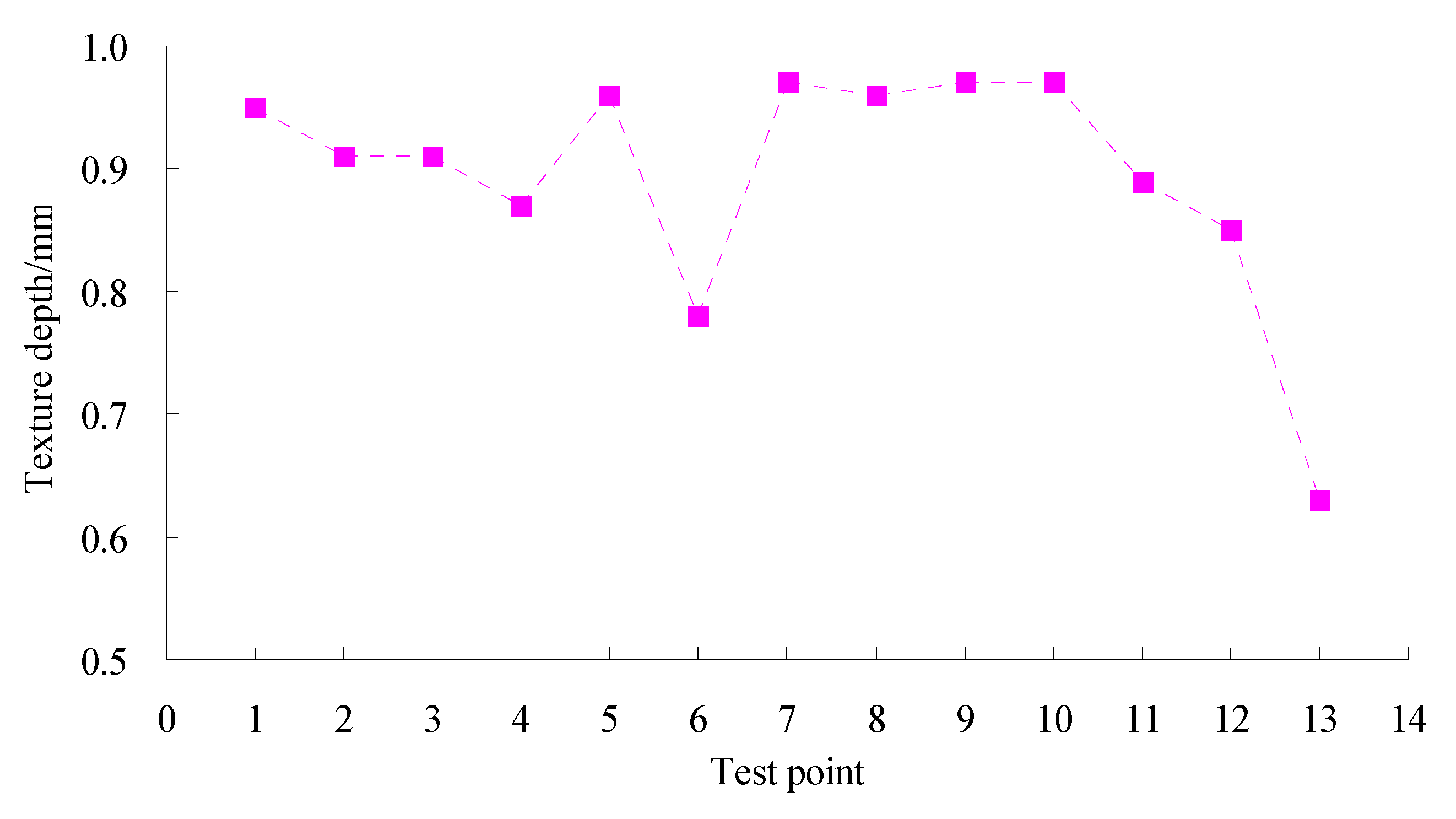
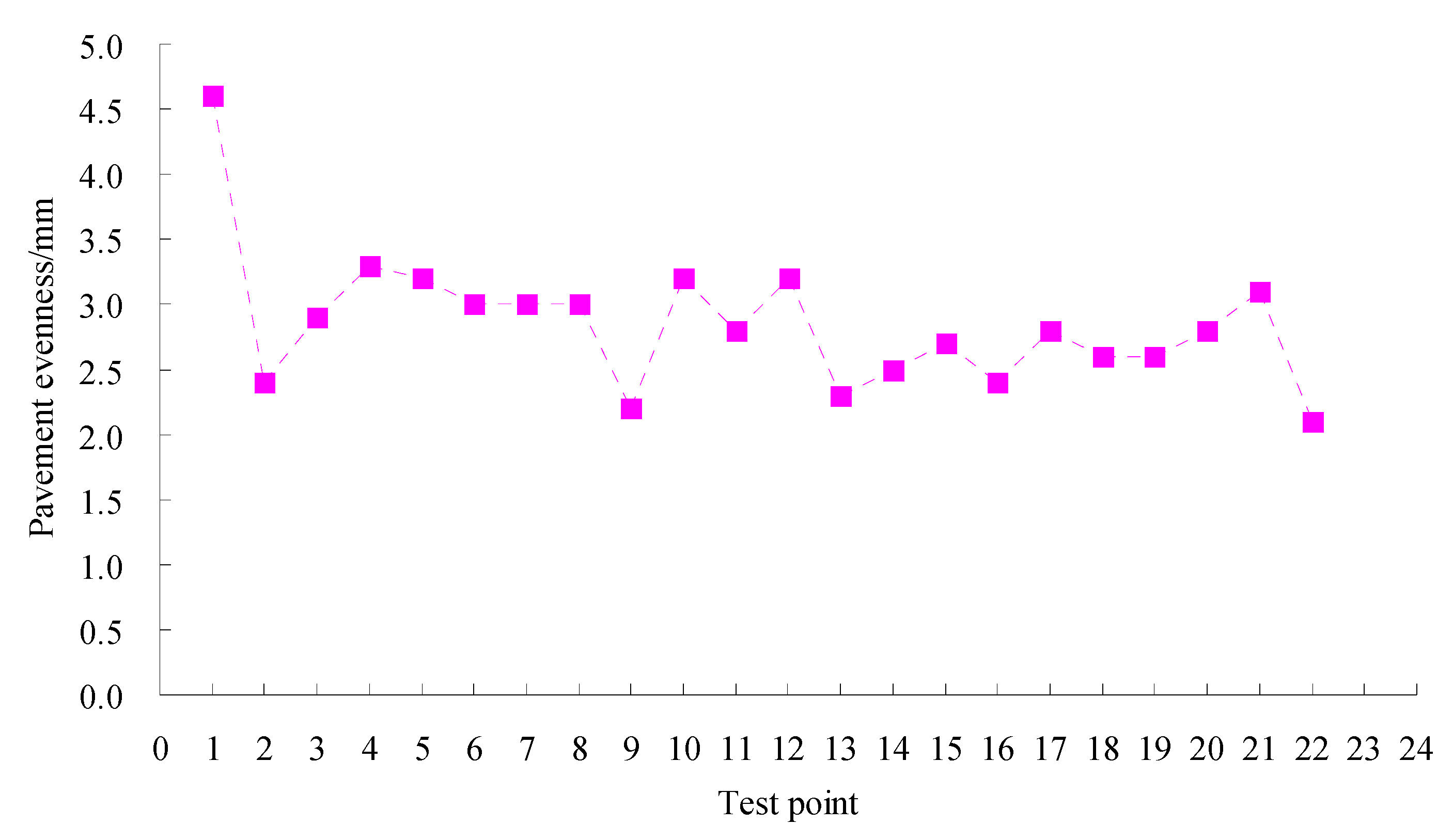
| Properties | Criteria | Results of Panjin 90# | Methods | |
|---|---|---|---|---|
| Ductility at 15 °C (cm) | ≥100 | >100 | T0605-2011 [26] | |
| Penetration degree at 25 °C (0.1 mm) | 80~100 | 83 | T0604-2011 [26] | |
| Softening point (°C) | ≥42 | 49.5 | T0606-2011 [26] | |
| Flash point (°C) | ≥245 | 285 | T0611-2011 [26] | |
| Wax content | 2.2 | 1.8 | T0615-2011 [26] | |
| Penetration index | −1.5~+1.0 | −0.4 | T0604-2011 [26] | |
| After TFOT (163 °C, 5 h) | Mass loss (%) | ±0.8 | 0.035 | T0609-2011 [26] |
| Penetration degree ratio at 25 °C (%) | ≥57 | 65 | T0604-2011 [26] | |
| Ductility at 15 °C (cm) | ≥8 | 14 | T0605-2011 [26] | |
| Properties | Colour | Density (g/cm3) | Rubber Hydrocarbon Content (%) | Rotation Viscosity at 25 °C | Flash Point | Benzene Content of Volatile Organic Compounds |
|---|---|---|---|---|---|---|
| (°C) | ||||||
| Criteria | - | 0.8~1.0 | >85 | 0.8 | 90~110 | 0.1 |
| Results | Blown | 0.88 | 83 | 0.71 | 66 | 0.07 |
| `Technical Indexes | Criteria | Results | Methods |
|---|---|---|---|
| Apparent density (g/cm3) | ≥2.5 | 2.704 | T0304-2005 [27] |
| Crush value (%) | ≤28 | 18.3 | T0316-2005 [27] |
| Content of acicular and flaky shape particles (%) | ≤20 | 10.1 | T0304-2005 [27] |
| Losses of Los Angeles Abrasion Test (%) | ≤30 | 17.2 | T0316-2005 [27] |
| Water absorption (%) | ≤3 | 0.701 | T0304-2005 [27] |
| Asphalt adhesion (graduation) | ≥4 | 4 | T0616-1993 [26] |
| Firmness (%) | ≤12 | 9 | T0314-2005 [27] |
| Mud content (%) | ≤3 | 0.1 | T0320-2005 [27] |
| Impact value (%) | ≤28 | 14.3 | T0322-2000 [27] |
| Properties | Criteria | Results | Methods |
|---|---|---|---|
| Apparent density (g/cm3) | ≥2.50 | 2.617 | T0328-2005 [27] |
| Water absorption (%) | ≤2 | 1.82 | T0340-2005 [27] |
| Sand equivalent (%) | ≥50 | 53 | T0334-2005 [27] |
| Properties | Criteria | Results | Methods | |
|---|---|---|---|---|
| Apparent density(g/cm3) | ≥2.50 | 2.661 | T0352-2005 [27] | |
| Water content (%) | ≤1 | 0.21 | T0305-1994 [27] | |
| Hydrophilic coefficient | <1 | 0.6 | T0353-2005 [27] | |
| Size distributions (%) | <0.6 mm | 100 | 100 | T0351-2005 [27] |
| <0.15 mm | 90~100 | 99.3 | ||
| <0.075 mm | 75~100 | 85.7 | ||
| Freeze-Thaw Splitting Strength (MPa) | Splitting Strength (MPa) | Freeze-Thaw Splitting Strength Ratio (%) | Criteria |
|---|---|---|---|
| 0.53 | 0.60 | 87.3 | ≥80% |
| Flexural Tensile Strength (MPa) | Failure Strain | Failure Stiffness Modulus (MPa) |
|---|---|---|
| 3.96 | 3064.27 | 1292.31 |
Publisher’s Note: MDPI stays neutral with regard to jurisdictional claims in published maps and institutional affiliations. |
© 2022 by the authors. Licensee MDPI, Basel, Switzerland. This article is an open access article distributed under the terms and conditions of the Creative Commons Attribution (CC BY) license (https://creativecommons.org/licenses/by/4.0/).
Share and Cite
Li, L.; Guo, Z.; Lin, Y. A Design Method of Styreneic Methyl Copolymers Normal Temperature Modified Asphalt Mixture Based on Performance Balance. Materials 2022, 15, 6193. https://doi.org/10.3390/ma15186193
Li L, Guo Z, Lin Y. A Design Method of Styreneic Methyl Copolymers Normal Temperature Modified Asphalt Mixture Based on Performance Balance. Materials. 2022; 15(18):6193. https://doi.org/10.3390/ma15186193
Chicago/Turabian StyleLi, Limin, Zhaoyang Guo, and Yuliang Lin. 2022. "A Design Method of Styreneic Methyl Copolymers Normal Temperature Modified Asphalt Mixture Based on Performance Balance" Materials 15, no. 18: 6193. https://doi.org/10.3390/ma15186193
APA StyleLi, L., Guo, Z., & Lin, Y. (2022). A Design Method of Styreneic Methyl Copolymers Normal Temperature Modified Asphalt Mixture Based on Performance Balance. Materials, 15(18), 6193. https://doi.org/10.3390/ma15186193







